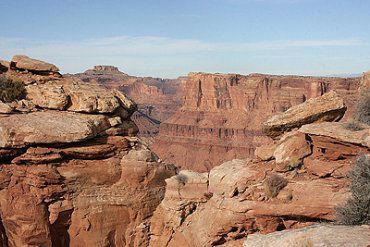The Emery County Public Lands council has been working on the Emery County Land Use Bill for two and a half years. The proposal is now awaiting approval from the state legislature or a part of the state legislature, namely the Natural Resources Committee. Along with this attempt to gain state approval is the need for the State of Utah School and Institutional Trust Lands Administration lands within the proposed wilderness areas as well as the National Conservation areas to be traded out of the land use bill.
John Andrews is the associate director of SITLA. Andrews attended the January public lands council meeting and then met with Commissioners Jeff Horrocks, James Nelson and Laurie Pitchforth as well as public lands consultant Randy Johnson, public lands director Ray Petersen, economic development director Mike McCandless and Clerk/Auditor Brenda Tuttle. Andrews brought along his intern Matt Kirkegaard who is attending the University of Utah.
In this meeting Andrews told of the formula used to compute royalties for oil, gas and mining activities on SITLA lands as well as federal lands including Bureau of Land Management and United States Forest Service Lands.
Johnson related to Andrews that Emery County would like to introduce the bill into Congress as early this year as possible. With this being an election year and Emery County is looked at frequently for monument status, the sooner the bill is introduced the better.
Andrews said they are interested in working with Emery County to identify possible land exchange lands. From SITLA’s perspective having lands tied up in lands with conservation designations doesn’t allow these lands to reach their full potential in raising and creating revenue for the school children of Utah.
Andrews explained the formula for oil and gas royalties on federal lands. Of the 12.5 percent collected half goes to the federal government and half goes to Utah for distribution back to the counties where the minerals are extracted to help minimize impacts to those counties. (CIB monies)
The formula was used when SITLA lands were exchanged in the Grand Staircase Escalante National Monument land exchange. Of the state share, 55 percent went to the producing county, 25 percent went to the county that gave up the land and 15 percent went into the state public land fund.
Currently a land exchange for recreational purposes for lands near Moab being exchanged for oil and gas production lands in Uintah County is held up due to the BLM not having the means to appraise the lands.
SITLA leases can collect up to 18.75 percent in royalties, which gives them one-third more money. SITLA could tell the federal government that they will keep paying them the 6.25 percent they would have gotten for having these lands leased and in that way avoid appraisals which slow down land exchanges. Emery County can benefit from these land exchanges because lands that are netting the county zero revenue at this time can be traded for lands that are producing and receive 25 percent of the royalties. SITLA is looking at trading around 80 percent of the land and keeping it within Emery County. Twenty percent of the trade lands would be looked for outside the county.
There is some interest in potash in the Green River area. Drilling is just beginning now in that area.
Johnson said the county would be happy to gain more productive lands and trade out lands that make sense.
It was discussed whether or not the land exchange should be part of the Emery County public lands use bill. “We wouldn’t want to be an anchor on your bill. Land exchanges are complicated,” said Andrews.
Johnson said he doesn’t think the bill can move forward without SITLA’s participation. There must be economic benefits involved for both a county that’s trading out and a receiving county.
Andrews said SITLA has already worked on a map and he will bring the map to the next public lands council meeting in February. Petersen suggested a work meeting at 9 a.m. to go over the map on Feb. 7.
The county estimated the acreage belonging to SITLA within the proposed land use bill is 28,800 acres. SITLA estimates that with lands in the Desolation Canyon area included, the exchange could be almost 100,000 acres. Andrews said he doesn’t see any way around the surface appraisals that must be done to facilitate the land exchanges. These can be time consuming as much as two-three years. Although land exchanges in the past were completed in a more timely manner, the political climate back then was different. Andrews thinks the land exchange process in Emery County will take some time to complete.
SITLA to work on land exchanges for land within the Emery County public land use bill

"Emery County views may be priceless, but when it comes to land exchanges how do you put a price tag on a view? This photo is a view towards Mexican Mountain. The viewpoint from San Rafael Reef."
